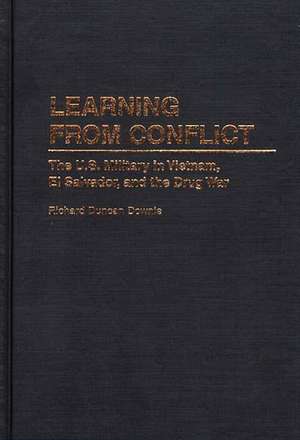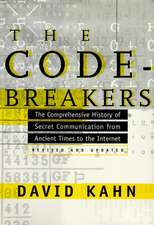Learning from Conflict: The U.S. Military in Vietnam, El Salvador, and the Drug War
Autor Richard D. Downieen Limba Engleză Hardback – 17 iun 1998 – vârsta până la 17 ani
Preț: 464.48 lei
Preț vechi: 610.64 lei
-24% Nou
Puncte Express: 697
Preț estimativ în valută:
88.88€ • 93.04$ • 73.54£
88.88€ • 93.04$ • 73.54£
Carte tipărită la comandă
Livrare economică 05-19 aprilie
Preluare comenzi: 021 569.72.76
Specificații
ISBN-13: 9780275960100
ISBN-10: 0275960102
Pagini: 312
Dimensiuni: 156 x 235 x 21 mm
Greutate: 0.65 kg
Editura: Bloomsbury Publishing
Colecția Praeger
Locul publicării:New York, United States
ISBN-10: 0275960102
Pagini: 312
Dimensiuni: 156 x 235 x 21 mm
Greutate: 0.65 kg
Editura: Bloomsbury Publishing
Colecția Praeger
Locul publicării:New York, United States
Notă biografică
RICHARD DUNCAN DOWNIE is currently Chief of the North and Central America Branch in the office of the U.S. Joint Chiefs of Staff, Strategy, Policy and Plans Directorate. He is also currently serving on the U.S. Delegation negotiating a possible U.S. presence in Panama after 1999. He has held a variety of command and staff positions and has written in scholarly and professional journals.
Cuprins
Preface and Reader's GuideAbbreviationsIntroduction and Theoretical OverviewOverview and BackgroundThe Sources of Doctrinal Change: Structuring Contending ExplanationsDevelopment and Evolution of U.S. Doctrine for Counterinsurgency and LICCase Study 1: Analyzing Change to Published Doctrine for Counterinsurgency in the Post-Vietnam War EraOfficial Army Studies on Counterinsurgency and Identifying ShortcomingsCounterinsurgency Doctrine in the Post-Vietnam War Era: Has There Been Conceptual Change?Did the U.S. Army Learn?: Assessing the Doctrinal EvidenceCase Study 2: Testing for Doctrinal Continuity: The U.S. Counterinsurgency Assistance Effort in El Salvador"Drawing the Line" in Central America: U.S. Counterinsurgency Assistance in El SalvadorCounterinsurgency from Vietnam to El Salvador: Testing for Doctrinal ContinuityWhy Didn't Counterinsurgency Doctrine Change After the Vietnam War: Testing HypothesesCase Study 3: Testing for Doctrinal Change or Continuity: The Drug War in the Andean RidgeFighting The Drug War on the Andean RidgeExplaining Doctrinal Change: The Drug War on the Andean RidgeConclusions and RecommendationsTheoretical ConclusionsRecommendations: LIC and Military Organizations as Learning InstitutionsAppendix: Measuring Change in Doctrine for CounterinsurgencySelected BibliographyIndex












